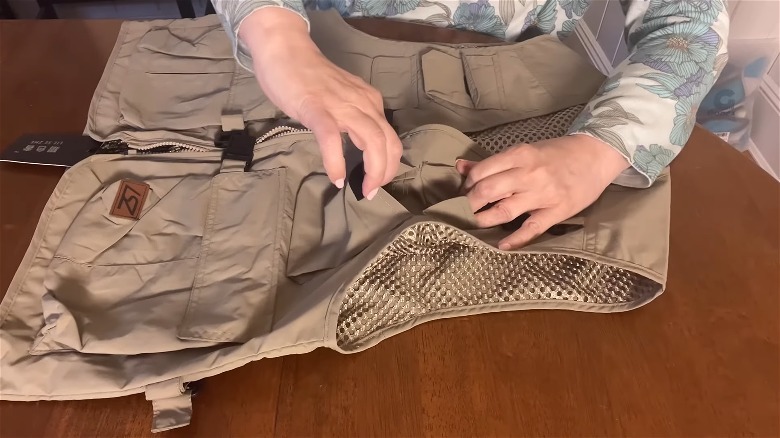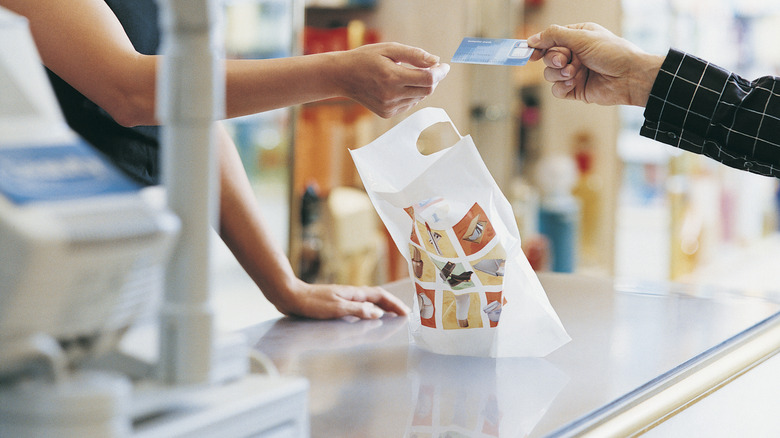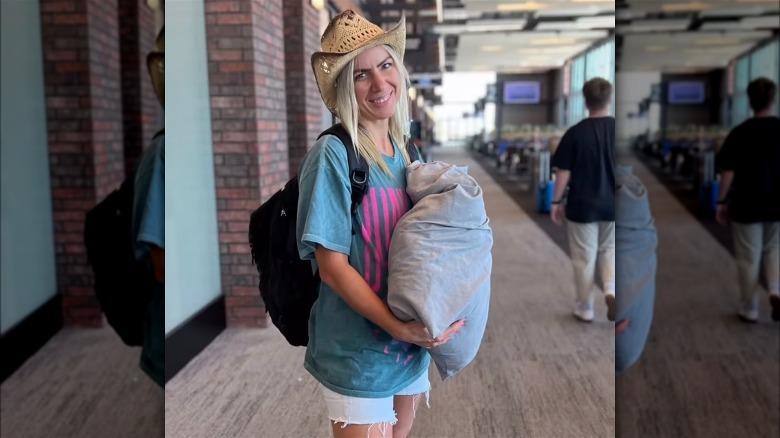Savvy Tips For Avoiding Never-Ending Airline Baggage Fees
Maybe you bought too many souvenirs in Osaka. Maybe you had to bring three different shoe options for your big night out on the town in Amsterdam. Maybe you had to find space for six different books to read while sunbathing on Toytoy Beach. Whatever the reason, you're out of space in your luggage, and your suitcase won't close no matter how much you sit on it. It's too late to repack using that 54321 method you keep hearing about. You know that checking a bag without paying for it in advance is a rookie flyer's mistake, but it's that or get slapped with a huge overweight baggage fee... unless you try out one of these tips.
Obviously, every airline has slightly different rules about what you can take onto a plane and what counts as a carry-on versus a personal item, and those rules can change. Often, it's simply up to the discretion of the gate agent whether or not something is acceptable, and there's no way to know for sure how strict they're going to be. Still, if it means avoiding yet another huge baggage fee, it's worth giving one of these unusual strategies a try first.
Wear a fishing vest
Social media has tips for everything involved with traveling, from getting a cheaper Airbnb to not being rude by putting your bag in the wrong overhead bin during the flight. One popular hack that's been making the rounds on TikTok is to buy a fishing vest to wear to the airport. These vests are known for their huge pockets which avid fishers use for storing lures, hooks, and bait. Some travelers have been using them for something else: anything that doesn't fit in their luggage.
These vests are relatively inexpensive and can fit a lot of things inside, so it's worth a try if you have more things to carry on the plane with you than actually fit in your bags. This strategy could definitely keep you from having to pay a fee — just make sure that you don't have anything in your pockets that isn't allowed on an airplane.
Stash clothes in a neck pillow
Spend enough time on YouTube and you'll see videos of people rolling up clothes and stuffing them into outrageous places to try to get them onto an airplane without paying those extra baggage fees. One of those strategies is to stick them into a neck pillow. It's definitely silly, but it also might work.
Many neck pillows designed to make you more comfortable on flights have a zipper that allows you to open up the pillow, take out the insert, and wash the cover. Some ingenuitive people have been filling the cover with their rolled-up clothes instead. In general, even the staff at fairly restrictive airlines don't care if you have a neck pillow with you and don't count it as a personal item, so this strategy could work. If you have no baggage allowance at all on your flight or you're really pushing it with a suspiciously bulging neck pillow, however, you might be asked to put it in your bag.
Pick up a duty-free bag at the airport
You might wonder how buying something else is going to help you get your already overstuffed luggage onto the plane, but stopping at the duty-free shop could be the exact right move for getting everything onto the plane without incurring any extra fees. Obviously, some airline luggage policies are too restrictive for this strategy, but usually, a duty-free bag usually doesn't count as part of your carry-on luggage, so you can just carry it right on the plane.
Usually, you can throw a couple of things from your luggage into a duty-free bag along with your new purchase and not run into any issues. You should probably try not to make it too obvious that's what you're doing, but as stated by one flight attendant in an interview with Express, the flight crew generally doesn't know and doesn't care what is in the bag, so feel free to throw that extra pair of boots inside!
Stuff a pillowcase
Most travel hacks will help you get one or two things onto a flight that were too heavy for your luggage, but according to some travelers, this tip might just let you skip an extra backpack completely. Some people are taking the stuffing and inserts out of their pillows and filling the pillowcase with their clothes. Not only can a lot of things fit inside, but it's basically still a functional pillow to keep you comfortable on the flight. Best of all? On some airlines, it's not really breaking any rules.
As described by a flight attendant in an interview with Business Insider, as long as you aren't trying to sneak anything onto the plane that's not allowed, it doesn't matter if you stick it into a backpack or a pillowcase, and it might keep you from getting hit with that overweight baggage fee. Unfortunately, it doesn't work on every flight. Make sure that you double-check the rules for what counts as a personal item on your preferred airline, though. A few major airlines consider a pillow a personal item, so if you're flying American Airlines, United, or Delta, you might as well just put your things in a bag.
Layer up
Everyone knows that you should wear your bulkiest clothes and your heaviest shoes onto the plane so they don't take up space in your luggage, so it makes sense that some passengers are taking that advice a step further. In 2019, one X user posted that his father had taken around 15 shirts out of his luggage to avoid having to pay for his bag being over the weight limit. He isn't alone. Some people don't even wait to find out if their bag weighs too much and preemptively layer multiple full outfits on top of each other so that they don't have to risk the fee.
In general, this tip is extremely effective because there's no rule about layering your clothes before you get on a flight. While airlines would love for you to pay an extra fee, the gate agent is not going to care if you're wearing two pairs of leggings under your jeans. That said, it is possible to take this too far. In May of 2023, a pair of teenagers found the limit to using this hack when they attempted to wear a full 13 lbs of clothing stacked on top of each other onto the plane, as well as stowing extra items into the clothes. They ended up paying a $40 fee.





